北京ACCA人才引进政策已公布,你心动了吗?
发布时间:2020-04-20
由于ACCA人才缺口大,市场需求量多,全国部分城市已经采取不同的政策来吸引ACCA人才,北京是我国的首都,是人才聚集的大城市,大家一起跟51题库考试学习网一起看看北京的政策吧!
北京:ACCA人才引进计划
在京发展的16项政策中指出,加强对高端金融人才ACCA等在引进住房保障医疗健康、教育培训、子女入学等方面的服务。不仅在个人所得税方面给予优惠,还可以办理调京手续,办理本市户口,井落户积分优惠。
北京ACCA政策你知道了,往下看还有更多福利!
珠海:落户补贴
珠海宣布出台《关于实施“珠海英才计划”加快集聚新时代创新创业人才的若干措施》,新政提到珠海每年将为人才引进投入25亿,提供福利包括落户补贴,住房产权,医疗,子女入学等一系列优惠。
在珠海出台的人才引进政策中,ACCA人才作为获得国际权威资格认证证书的金融审计师,被列入《珠海市紧缺人才开发目录》当中,持有ACCA证书的财务人,一旦落户珠海,可以直接获得20万落户补贴。对于被评定为高端稀缺人才的,补贴额度还会更高。
重庆:购房补贴+人才补贴
重庆市渝北区印发了《大力实施创新驱动发展战略加快建设创新生态圈的若干政策》及相关配套文件,落实引进临空创新人才。
(1)购房补贴
ACCA被列入临空创新人才目录,最高可获200万元项目资金,60万元人才补贴,25万元一次性购房补贴。临空创新人才及其配偶、子女户口可随调随迁。
(2)人才补贴
文件中明确指出,将国际权威的职业资格认证ACCA列入临空经营管理B类及C类人才目录,分别享60万元和10万元人才补贴及其他优惠政策。
西安:生活补贴
西安高新区“五八八二”三次创业战略列为“积极吸引高端金融人才”,根据西安公布的《西安市加快金融业发展的若干扶持办法》中,明确将ACCA人才列为“具备国际资质的高端金融人才”,
获得ACCA(特许公认会计师公会会员)专业资质的金融从业人员,给予每人最高50万元的工作生活补贴。
成都:落户补贴
成都天府新区成都直管区召开发布会,重磅推出成都《天府新区成都直管区“天府英才计划”实施办法》计划中指出,55周岁以下,近5年取得ACCA专业资格证书,且在直管区注册的金融机构担任高级管理职务两年以上的财会人可以直接申请成为B类高端人才。按照“天府英才计划”,高端人才B类可以获得高达80万的落户安家补贴,医疗,子女入学等优惠福利。
上海:居住证加分+现金奖励
已办理上海居住证的ACCA持证人,凭ACCA证书可获得落户30积分,此外,对于想去会计师事务所的ACCA持证人,可根据《上海市注册会计师协会行业人才管理培养办法》获得10,000元奖励。
广州:落户补贴
ACCA持证人可享受广州市政府提供的安家补贴,具体数额为最高不超过100万元,非广州户籍的金融人才和配偶,子女,可在购房、购车、子女入学等方面享受广州市民同等待遇,在落户上享受优先办理
此外,深圳市罗湖区制定和实施高层次产业人才“菁英计划”对三类“菁英人才”实行不同的人才待遇标准,其中把国际职业资格——ACCA(特许公认会计师)列入B类“菁英人才”认定标准。提供住房安居、创业支持、健康管理、研修资助、联谊交流、子女入学、父母养老等服务。
以上就是51题库考试学习网提供的ACCA各地福利信息,你有没有心动呢?心动的同学就赶紧拥有ACCA证书吧,以上福利都是你的。更多资讯关注51题库考试学习网。
下面小编为大家准备了 ACCA考试 的相关考题,供大家学习参考。
In 2014 Mr Yuan inherited an estate of RMB2 million from his uncle who had died two months earlier.
What is the correct treatment of the estate income for individual income tax purposes?
A.The estate income is not taxable
B.The estate income will be taxed as occasional (ad hoc) income
C.The estate income will be taxed as other income
D.The estate income will be taxed as service income
5 GE Railways plc (GER) operates a passenger train service in Holtland. The directors have always focused solely on
the use of traditional financial measures in order to assess the performance of GER since it commenced operations
in 1992. The Managing Director of GER has asked you, as a management accountant, for assistance with regard to
the adoption of a balanced scorecard approach to performance measurement within GER.
Required:
(a) Prepare a memorandum explaining the potential benefits and limitations that may arise from the adoption of
a balanced scorecard approach to performance measurement within GER. (8 marks)
(a) To: Board of directors
From: Management Accountant
Date: 8 June 2007
The potential benefits of the adoption of a balanced scorecard approach to performance measurement within GER are as
follows:
A broader business perspective
Financial measures invariably have an inward-looking perspective. The balanced scorecard is wider in its scope and
application. It has an external focus and looks at comparisons with competitors in order to establish what constitutes best
practice and ensures that required changes are made in order to achieve it. The use of the balanced scorecard requires a
balance of both financial and non-financial measures and goals.
A greater strategic focus
The use of the balanced scorecard focuses to a much greater extent on the longer term. There is a far greater emphasis on
strategic considerations. It attempts to identify the needs and wants of customers and the new products and markets. Hence
it requires a balance between short term and long term performance measures.
A greater focus on qualitative aspects
The use of the balanced scorecard attempts to overcome the over-emphasis of traditional measures on the quantifiable aspects
of the internal operations of an organisation expressed in purely financial terms. Its use requires a balance between
quantitative and qualitative performance measures. For example, customer satisfaction is a qualitative performance measure
which is given prominence under the balanced scorecard approach.
A greater focus on longer term performance
The use of traditional financial measures is often dominated by financial accounting requirements, for example, the need to
show fixed assets at their historic cost. Also, they are primarily focused on short-term profitability and return on capital
employed in order to gain stakeholder approval of short term financial reports, the longer term or whole life cycle often being
ignored.
The limitations of a balanced scorecard approach to performance measurement may be viewed as follows:
The balanced scorecard attempts to identify the chain of cause and effect relationships which will provide the stimulus for
the future success of an organisation.
Advocates of a balanced scorecard approach to performance measurement suggest that it can constitute a vital component
of the strategic management process.
However, Robert Kaplan and David Norton, the authors of the balanced scorecard concept concede that it may not be suitable
for all firms. Norton suggests that it is most suitable for firms which have a long lead time between management action and
financial benefit and that it will be less suitable for firms with a short-term focus. However, other flaws can be detected in
the balanced scorecard.
The balanced scorecard promises to outline the theory of the firm by clearly linking the driver/outcome measures in a cause
and effect chain, but this will be difficult if not impossible to achieve.
The precise cause and effect relationships between measures for each of the perspectives on the balanced scorecard will be
complex because the driver and outcome measures for the various perspectives are interlinked. For example, customer
satisfaction may be seen to be a function of several drivers, such as employee satisfaction, manufacturing cycle time and
quality. However, employee satisfaction may in turn be partially driven by customer satisfaction and employee satisfaction
may partially drive manufacturing cycle time. A consequence of this non-linearity of the cause and effect chain (i.e., there is
non-linear relationship between an individual driver and a single outcome measure), is that there must be a question mark
as to the accuracy of any calculated correlations between driver and outcome measures. Allied to this point, any calculated
correlations will be historic. This implies that it will only be possible to determine the accuracy of cause and effect linkages
after the event, which could make the use of the balanced scorecard in dynamic industries questionable. If the market is
undergoing rapid evolution, for example, how meaningful are current measures of customer satisfaction or market share?
These criticisms do not necessarily undermine the usefulness of the balanced scorecard in presenting a more comprehensive
picture of organisational performance but they do raise doubts concerning claims that a balanced scorecard can be
constructed which will outline a clear cause and effect chain between driver and outcome measures and the firm’s financial
objectives.
22 Which of the following items may appear in a company’s statement of changes in equity, according to IAS 1 Presentation of financial statements?
1 Unrealised revaluation gains.
2 Dividends paid.
3 Proceeds of equity share issue.
4 Profit for the period.
A 2, 3 and 4 only
B 1, 3 and 4 only
C All four items
D 1, 2 and 4 only
(b) Prepare a consolidated statement of financial position of the Ribby Group at 31 May 2008 in accordance
with International Financial Reporting Standards. (35 marks)

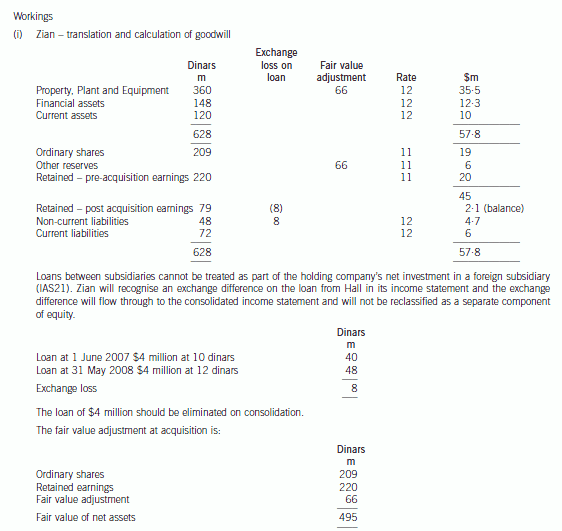


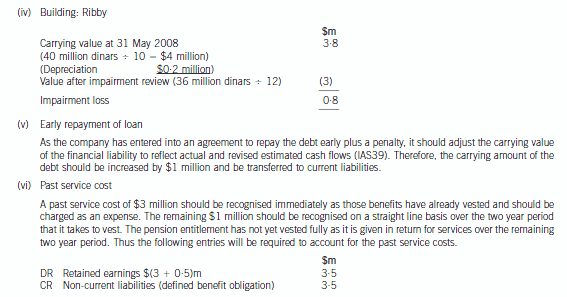
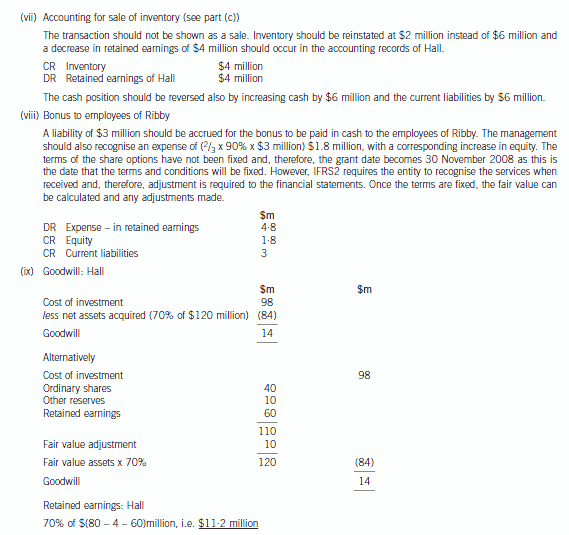
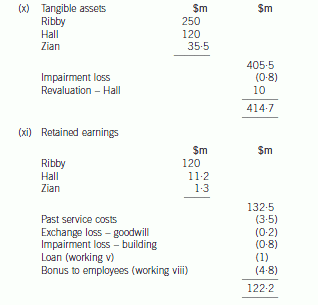
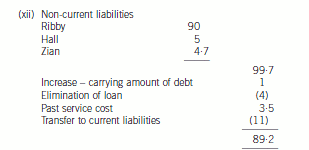
声明:本文内容由互联网用户自发贡献自行上传,本网站不拥有所有权,未作人工编辑处理,也不承担相关法律责任。如果您发现有涉嫌版权的内容,欢迎发送邮件至:contact@51tk.com 进行举报,并提供相关证据,工作人员会在5个工作日内联系你,一经查实,本站将立刻删除涉嫌侵权内容。
- 2020-01-10
- 2020-05-16
- 2020-09-03
- 2020-01-10
- 2020-01-10
- 2020-04-09
- 2020-05-08
- 2020-01-10
- 2020-01-10
- 2020-05-16
- 2020-03-29
- 2020-01-10
- 2021-06-26
- 2020-03-01
- 2021-07-28
- 2020-01-10
- 2020-04-21
- 2020-01-10
- 2020-02-19
- 2020-01-10
- 2020-01-30
- 2020-01-10
- 2020-01-10
- 2020-01-09
- 2020-01-10
- 2020-03-07
- 2020-09-03
- 2020-04-16
- 2020-02-05
- 2020-04-29